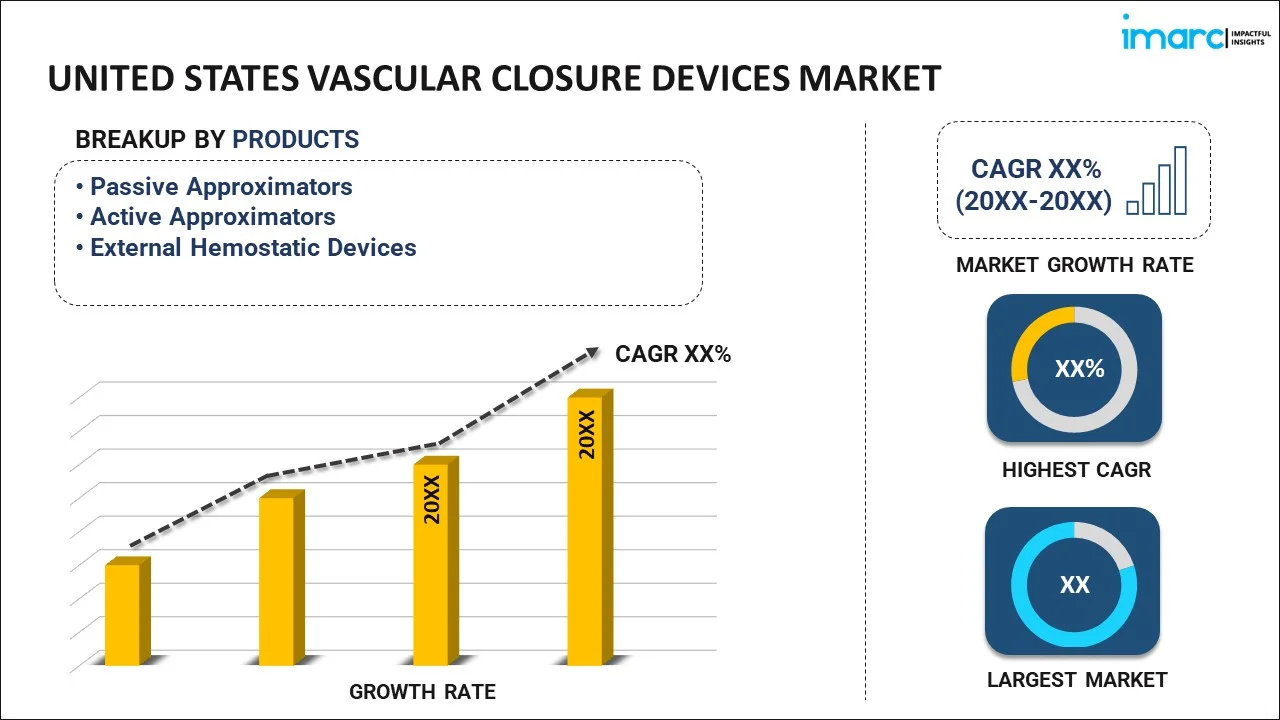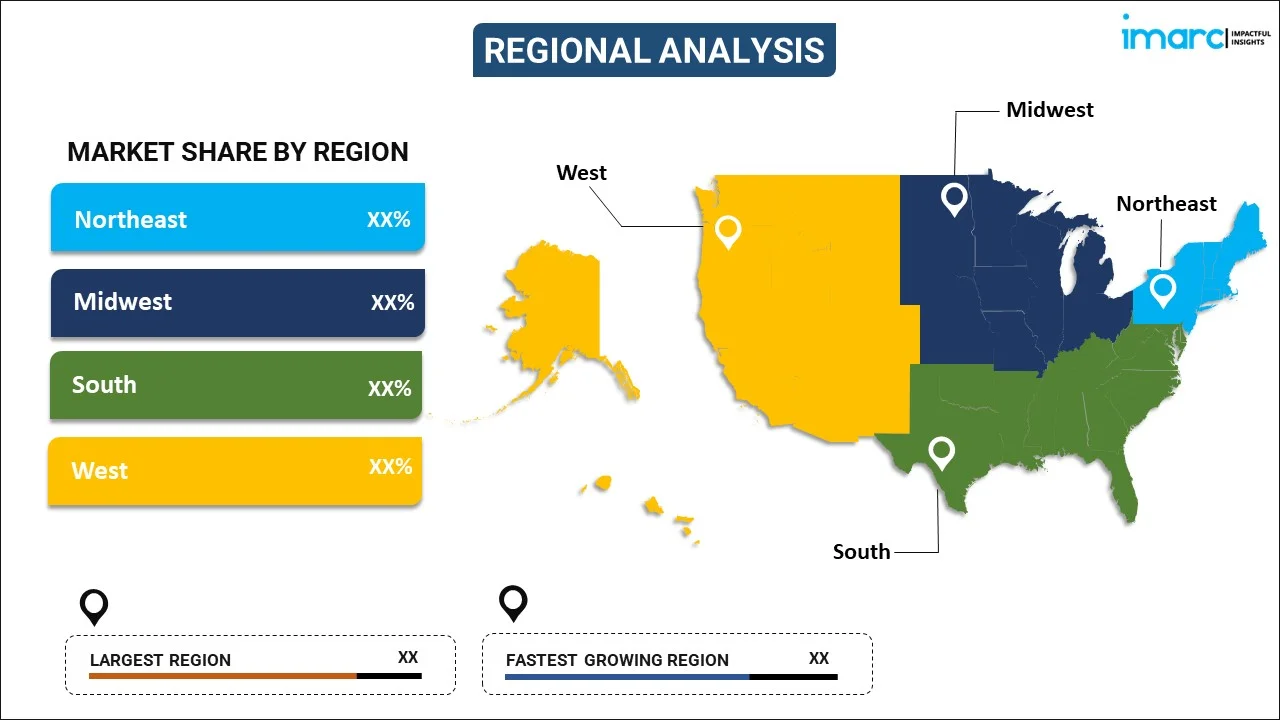
United States Vascular Closure Devices Market Report by Product (Passive Approximators, Active Approximators, External Hemostatic Devices), Access (Femoral Access, Radial Access), Procedure (Interventional Cardiology, Interventional Radiology/Vascular Surgery), End User (Hospitals, Ambulatory Surgical Centers, and Others), and Region 2025-2033
United States Vascular Closure Devices Market Size, Share & Analysis
United States vascular closure devices market size is projected to exhibit a growth rate (CAGR) of 6.57% during 2025-2033. The growing prevalence of coronary artery and peripheral artery diseases, rising preference for minimally invasive (MI) procedures among patients, and increasing collaborations between manufacturers and healthcare providers represent some of the key factors driving the market.
|
Report Attribute
|
Key Statistics
|
|---|---|
|
Base Year
|
2024 |
|
Forecast Years
|
2025-2033
|
|
Historical Years
|
2019-2024
|
| Market Growth Rate (2025-2033) | 6.57% |
Vascular closure devices (VCDs) are specialized medical instruments that quickly and safely close the puncture site in a vessel following cardiovascular procedures like angiography or angioplasty. They are manufactured using biocompatible materials, ensuring safety and compatibility with human tissues. They are available in various types, including collagen plug-based, suture-based, and clip-based devices, each suited for specific clinical scenarios. They reduce the discomfort associated with prolonged manual compression at the access site, enhancing the overall experience of patients. They contribute to improved patient outcomes and reduced healthcare costs by minimizing the risk of bleeding complications. They enable healthcare providers to complete procedures more efficiently, reducing procedure time and radiation exposure for both patients and clinicians. They lower complications, which results in shorter hospital stays, leading to cost savings for healthcare facilities. They are utilized in interventional cardiology and radiology, offering an efficient and effective solution for vessel closure.
United States Vascular Closure Devices Market Trends:
At present, the rising prevalence of conditions, such as coronary artery disease, peripheral artery disease, and hypertension represents one of the key factors impelling the growth of the market in the United States. Moreover, increasing technological innovations, such as bioabsorbable materials, which reduce the risk of infection and improve biocompatibility and advancements in device design, are contributing to the market growth. This technological progression is not only improving patient outcomes but is also making the devices more appealing to healthcare providers. Besides this, the growing geriatric population that is more susceptible to cardiovascular diseases and requires cardiac interventions like angiography and angioplasty is offering a favorable market outlook in the country. Additionally, rising preferences for minimally invasive (MI) procedures among patients is catalyzing the demand for VCDs to recovery quickly and reduce hospital stays. The increasing awareness about the benefits of VCDs among patients, influenced by digital platforms and patient education programs, is also contributing to the market growth in the country. Apart from this, increasing strategic partnerships and collaborations between VCD manufacturers, healthcare providers, and research institutions are leading to clinical trials, product innovations, and improved training and education programs for healthcare professionals. In addition, the growing integration of digital technologies, including data analytics, artificial intelligence (AI), and machine learning (ML) in healthcare for patient data analysis, is resulting in more personalized care and better decision-making in the use of VCDs. Furthermore, the rising shift towards more patient-centric approaches in device development is encouraging the adoption of VCDs as they minimize pain, reduce anxiety, and accelerate recovery.
United States Vascular Closure Devices Market Segmentation:
IMARC Group provides an analysis of the key trends in each segment of the market, along with forecasts at the country level for 2025-2033. Our report has categorized the market based on product, access, procedure, and end user.
Product Insights:

- Passive Approximators
- Collagen Plugs
- Sealant or Gel-Based Devices
- Compression-Assist Devices
- Active Approximators
- Suture-Based Devices
- Clip-Based Devices
- External Hemostatic Devices
The report has provided a detailed breakup and analysis of the market based on the product. This includes passive approximators (collagen plugs, sealant or gel-based devices, and compression-assist devices), active approximators (suture-based devices and clip-based devices), and external hemostatic devices.
Access Insights:
- Femoral Access
- Radial Access
A detailed breakup and analysis of the market based on the access have also been provided in the report. This includes femoral access and radial access.
Procedure Insights:
- Interventional Cardiology
- Interventional Radiology/Vascular Surgery
The report has provided a detailed breakup and analysis of the market based on the procedure. This includes interventional cardiology and interventional radiology/vascular surgery.
End User Insights:
- Hospitals
- Ambulatory Surgical Centers
- Others
A detailed breakup and analysis of the market based on the end user have also been provided in the report. This includes hospitals, ambulatory surgical centers, and others.
Regional Insights:

- Northeast
- Midwest
- South
- West
The report has also provided a comprehensive analysis of all the major regional markets, which include the Northeast, Midwest, South, and West.
Competitive Landscape:
The market research report has also provided a comprehensive analysis of the competitive landscape. Competitive analysis such as market structure, key player positioning, top winning strategies, competitive dashboard, and company evaluation quadrant has been covered in the report. Also, detailed profiles of all major companies have been provided.
United States Vascular Closure Devices Market Report Coverage:
| Report Features | Details |
|---|---|
| Base Year of the Analysis | 2024 |
| Historical Period | 2019-2024 |
| Forecast Period | 2025-2033 |
| Units | Million USD |
| Scope of the Report | Exploration of Historical and Forecast Trends, Industry Catalysts and Challenges, Segment-Wise Historical and Predictive Market Assessment:
|
| Products Covered |
|
| Accesses Covered | Femoral Access, Radial Access |
| Procedures Covered | Interventional Cardiology, Interventional Radiology/Vascular Surgery |
| End Users Covered | Hospitals, Ambulatory Surgical Centers, Others |
| Regions Covered | Northeast, Midwest, South, West |
| Customization Scope | 10% Free Customization |
|
Post-Sale Analyst Support |
10-12 Weeks |
| Delivery Format | PDF and Excel through Email (We can also provide the editable version of the report in PPT/Word format on special request) |
Key Questions Answered in This Report:
- How has the United States vascular closure devices market performed so far and how will it perform in the coming years?
- What has been the impact of COVID-19 on the United States vascular closure devices market?
- What is the breakup of the United States vascular closure devices market on the basis of product?
- What is the breakup of the United States vascular closure devices market on the basis of access?
- What is the breakup of the United States vascular closure devices market on the basis of procedure?
- What is the breakup of the United States vascular closure devices market on the basis of end user?
- What are the various stages in the value chain of the United States vascular closure devices market?
- What are the key driving factors and challenges in the United States vascular closure devices?
- What is the structure of the United States vascular closure devices market and who are the key players?
- What is the degree of competition in the United States vascular closure devices market?
Key Benefits for Stakeholders:
- IMARC’s industry report offers a comprehensive quantitative analysis of various market segments, historical and current market trends, market forecasts, and dynamics of the United States vascular closure devices market from 2019-2033.
- The research report provides the latest information on the market drivers, challenges, and opportunities in the United States vascular closure devices market.
- Porter's five forces analysis assist stakeholders in assessing the impact of new entrants, competitive rivalry, supplier power, buyer power, and the threat of substitution. It helps stakeholders to analyze the level of competition within the United States vascular closure devices industry and its attractiveness.
- Competitive landscape allows stakeholders to understand their competitive environment and provides an insight into the current positions of key players in the market.
Need more help?
- Speak to our experienced analysts for insights on the current market scenarios.
- Include additional segments and countries to customize the report as per your requirement.
- Gain an unparalleled competitive advantage in your domain by understanding how to utilize the report and positively impacting your operations and revenue.
- For further assistance, please connect with our analysts.
 Request Customization
Request Customization
 Speak to an Analyst
Speak to an Analyst
 Request Brochure
Request Brochure
 Inquire Before Buying
Inquire Before Buying




.webp)




.webp)












